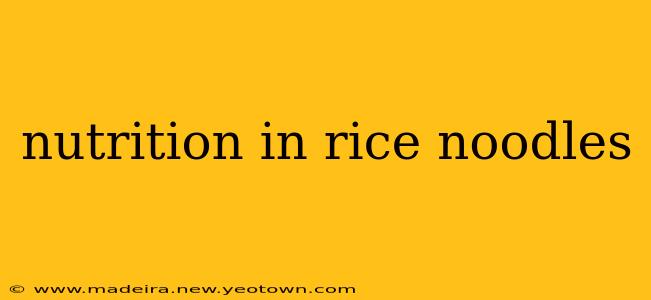Rice noodles, those delicate strands that form the backbone of countless dishes across the globe, often get overlooked in the nutrition conversation. We tend to think of them as a relatively neutral base, a blank canvas for vibrant sauces and flavorful toppings. But the truth is, rice noodles possess a unique nutritional profile that deserves a closer look. This isn't just about calories; it's about understanding the subtle contributions rice noodles make to a balanced diet, and how they can fit into various health goals.
My journey into the world of rice noodles began with a simple question: Are they truly as nutritionally "empty" as some believe? My research, spanning nutritional databases, scientific articles, and even conversations with culinary experts, revealed a fascinating story – one that goes beyond simple carbohydrates.
What are rice noodles made of?
Rice noodles, as the name suggests, are primarily made from rice flour. This simple ingredient gives them their characteristic soft texture and neutral flavor. Different types of rice, such as brown rice, white rice, and even glutinous rice, can be used in their production, leading to slight variations in nutritional content. However, the fundamental building blocks remain similar: primarily carbohydrates. But let's not dismiss carbohydrates so quickly! They are our primary source of energy, fueling our daily activities.
Are rice noodles healthy?
This is a question that deserves a nuanced answer. The healthiness of rice noodles, like many foods, depends heavily on context. On their own, they provide a modest amount of carbohydrates and some trace minerals. However, their nutritional value significantly increases when incorporated into a balanced meal containing vegetables, lean proteins, and healthy fats. Think of them as a vehicle for other nutrients, rather than a source of nutrients themselves.
How many calories are in rice noodles?
The calorie count in rice noodles varies based on the type and serving size. Generally, a typical serving (around 1 cup cooked) contains between 150-200 calories. However, this can increase significantly if the noodles are prepared with heavy sauces or added ingredients high in fat and sugar. So portion control and mindful preparation are key to keeping calorie intake in check.
What are the benefits of eating rice noodles?
While not a powerhouse of vitamins and minerals, rice noodles do offer some benefits:
- Quick Energy Source: Their carbohydrate content makes them a fast and readily available source of energy, particularly beneficial for those who are active or need a quick boost.
- Gluten-Free Option: For individuals with celiac disease or gluten sensitivity, rice noodles offer a safe and delicious alternative to wheat-based pasta.
- Versatility: Their mild flavor allows them to complement a wide array of cuisines and flavors, fostering culinary creativity.
What are the downsides of eating rice noodles?
Like any food, moderation is key. Some potential downsides of rice noodle consumption include:
- High Glycemic Index (GI): Depending on the type of rice used, rice noodles can have a relatively high GI, meaning they can cause a rapid spike in blood sugar levels. This is particularly important for people with diabetes or those who are managing their blood sugar.
- Low in Protein and Fiber: Rice noodles are relatively low in protein and fiber, highlighting the importance of pairing them with other nutrient-rich foods to create a balanced meal.
Are rice noodles good for weight loss?
This depends entirely on the overall context of your diet. While rice noodles themselves aren't inherently fattening, overconsumption, particularly when combined with high-calorie sauces and toppings, can hinder weight loss efforts. Including them as part of a calorie-controlled diet, paired with plenty of fruits, vegetables, and lean protein, is entirely possible within a weight-management plan.
What is the best way to cook rice noodles?
Cooking rice noodles properly is crucial for achieving the best texture and flavor. Follow the package instructions carefully, as cooking times and methods can vary slightly depending on the brand. Overcooking can result in mushy noodles, while undercooking can leave them too firm.
In conclusion, rice noodles are not a magic bullet for health or weight loss, but they can certainly be a delicious and versatile part of a balanced diet. Understanding their nutritional profile, choosing wisely when selecting ingredients, and incorporating them thoughtfully into your meal planning are crucial for maximizing their benefits and minimizing potential downsides. The journey to discovering the nutritional landscape of rice noodles is ongoing, reminding us that informed choices are the key to healthy eating.

